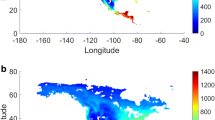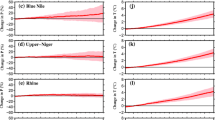Abstract
Northern Eurasian ecosystems play an important role in the global climate system. Northern Eurasia (NE) has experienced dramatic climate changes during the last half of the 20th century and to present. To date, how evapotranspiration (ET) and water availability (P–ET, P: precipitation) had changed in response to the climatic change in this region has not been well evaluated. This study uses an improved version of the Terrestrial Ecosystem Model (TEM) that explicitly considers ET from uplands, wetlands, water bodies and snow cover to examine temporal and spatial variations in ET, water availability and river discharge in NE for the period 1948–2009. The average ET over NE increased during the study period at a rate of 0.13 mm year−1 year−1. Over this time, water availability augmented in the western part of the region, but decreased in the eastern part. The consideration of snow sublimation substantially improved the ET estimates and highlighted the importance of snow in the hydrometeorology of NE. We also find that the modified TEM estimates of water availability in NE watersheds are in good agreement with corresponding measurements of historical river discharge before 1970. However, a systematic underestimation of river discharge occurs after 1970 indicates that other water sources or dynamics not considered by the model (e.g., melting glaciers, permafrost thawing and fires) may also be important for the hydrology of the region.




Similar content being viewed by others
References
Adam JC, Lettenmaier DP (2008) Application of New precipitation and reconstructed discharge products to discharge trend attribution in Northern Eurasia. J Clim 21(8):1807–1828
Adam JC, Haddeland I, Su F, Lettenmaier DP (2007) Simulation of reservoir influences on annual and seasonal discharge changes for the Lena, Yenisei, and Ob’rivers. J Geophys Res Atmos 112:D24 (1984–2012)
Arctic Climate Impact Assessment (ACIA) (2005) Cambridge University Press, New York, p 1042
ASCE (American Society of Civil Engineers) (1996) Hydrology handbook. ASCE manuals and reports on engineering practice No. 28. ASCE, New York
Bates B, Kundzewicz ZW, Wu S, Palutikof J (2008) IPCC: Climate change and water
Dolman AJ, De Jeu R (2010) Evaporation in focus. Nat Geosci 3(5):296–296
Dorigo WJR, Chung D, Parinussa R, Liu Y, Wagner W, Fernández-Prieto D (2012) Evaluating global trends (1988–2010) in harmonized multi‐satellite surface soil moisture. Geophys Res Lett 39:18
Douville H, Ribes A, Decharme B, Alkama R, Sheffield J (2012) Anthropogenic influence on multidecadal changes in reconstructed global evapotranspiration. Nat Clim Chang 3:59–62
Feddes RA, Lenselink KJ (1994) Evapotranspiration. In: H.P. Ritzema (ed) Drainage principles and applications. Water Resources Pubns, Wageningen, The Netherlands, p 1125
Fisher JB, Tu KP, Baldocchi DD (2008) Global estimates of the land–atmosphere water flux based on monthly AVHRR and ISLSCP-II data, validated at 16 FLUXNET sites. Remote Sens Environ 112(3):901–919
Frey KE, Smith LC (2003) Recent temperature and precipitation increase in West Sibria and their association with the Arctic Oscillation. Polar Res 22(2):287–300
Froehlich K (2000) Evaluating the water balance of inland seas using isotopic tracers: the Caspian Sea experience. Hydrol Process 14(8):1371–1383
Groisman PY, Clark EA, Kattsov VM, Lettenmaier DP et al (2009) The Northern Eurasia earth science partnership: an example of science applied to societal needs. Bull Am Meteorol Soc 5:671–688
Groisman P, Gutman G, Reissell A (2010) Introduction: climate and land-cover changes in the arctic. In: Gutman G, Reissell A (eds) Eurasian arctic land cover and land use in a changing climate. Springer, London, pp 1–8
Hamed KH, Rao AR (1998) A modified Mann–Kendall trend test for autocorrelated data. J Hydrol 204:182–196
Harris I, Jones P, Osborn T, Lister D (2013) Updated high‐resolution grids of monthly climatic observations–the CRU TS3. 10 dataset. Int J Climatol. doi:10.1002/joc.3711
Held IM, Soden BJ (2000) Water vapor feedback and global warming. Annu Rev Energy Environ 25:441–475
Huntington TG (2006) Evidence for intensification of the global water cycle: review and synthesis. J Hydrocarb 319(1):83–95
IPCC (2013) Climate change 2013: the physical science basis. Working Group I Contribution to the Fifth Assessment Report of the Intergovernmental Panel on Climate Change, Summary for Policymakers, IPCC
Jensen ME, Haise HR (1963) Estimating evapotranspiration from solar radiation, Proceedings of the American Society of Civil Engineers. J Irr Drain Div 89:15–41
Jin Y, Schaaf CB, Woodcock CE, Gao F, Li X, Strahler AH, Lucht W, Liang S (2003a) Consistency of MODIS surface bidirectional reflectance distribution function and albedo retrievals: 1. Algorithm performance. J Geophys Res 108(D5)
Jin Y, Schaaf CB, Woodcock CE, Gao F, Li X, Strahler AH, Lucht W, Liang S, (2003b) Consistency of MODIS surface bidirectional reflectance distribution function and albedo retrievals: 2. Validation J Geophys Res 108(D5)
John R et al (2013) Vegetation response to extreme climate events on the Mongolian Plateau from 2000–2010. Environ Res Lett 8:035033
Jung M et al (2010) Recent decline in the global land evapotranspiration trend due to limited moisture supply. Nature 467(7318):951–954
Kumar S, Lawrence DM, Dirmeyer PA, Sheffield J (2014) Less reliable water availability in the 21st century climate projections. Earth’s Futur 2:152–160
Liu Y, Zhuang Q, Chen M, Tchebakova N, Pan Z et al (2013) Response of evapotranspiration and water availability to changing climate and land cover on the Mongolian Plateau during the 21st century. Global Planet Chang 108:85–99
McClelland JW, Holmes RM, Peterson BJ, Stieglitz M (2004) Increasing river discharge in the Eurasian Arctic: consideration of dams, permafrost thaw, and fires as potential agents of change. J Geophys Res-Atmos 109:D18 (1984–2012)
Mengelkamp H-T et al (2006) Evaporation over a heterogeneous land surface: the EVA-GRIPS project. Bull Am Meteorol Soc 87:775–786
Miralles DG, De Jeu RAM, Gash JH, Holmes TRH, Dolman AJ (2011a) Magnitude and variability of land evaporation and its components at the global scale. Hydrol Earth Syst Sci 15(3):967–981
Miralles DG, De Jeu RAM, Gash JH, Holmes TRH, Dolman AJ (2011b) Global land-surface evaporation estimated from satellite-based observations. Hydrol Earth Syst Sci 15(2):453–469
Mohamed YA, Bastiaanssen WGM, Savenije HHG, van den Hurk BJJM, Finlayson CM (2012) Wetland versus open water evaporation: an analysis and literature review. Phys Chem Earth 47–48:114–121
Monteith JL (1965) Evaporation and environment. Symp Soc Exp Biol 19:205–224
Mu Q, Zhao M, Running SW (2011) Improvements to a MODIS global terrestrial evapotranspiration algorithm. Remote Sens Environ 115(8):1781–1800
Mueller B et al (2013) Benchmark products for land evapotranspiration: LandFlux-EVAL multi-dataset synthesis. Hydrol Earth Syst Sci 17:3707–3720
NEESPI (2004) The Northern Eurasia Earth Science Partnership Initiative (NEESPI), Executive Overview
Pan Y, Mcguire AD, Kicklighter DW, Melillo JM (1996) The importance of climate and soils for estimates of net primary production: a sensitivity analysis with the terrestrial ecosystem model. Glob Change Biol 2(1):5–23
Penman HL (1948) Natural evaporation from open water, bare soil and grass. Proceedings of the Royal Society of London, Series A Mathematical and Physical Sciences 193(1032):120–145
Penman HL (1956) Evaporation: an introductory survey. Neth J Agr Sci 4(1):9–29
Peterson BJ et al (2002) Increasing river discharge to the Arctic Ocean. Science 298(5601):2171–2173
Romanou A, Tselioudis G, Zerefos CS, Clayson CA, Curry JA, Andersson A (2010) Evaporation-precipitation variability over the Mediterranean and the Black Seas from satellite and reanalysis estimates. J Clim 23(19):5268–5287
Salomon J, Schaaf CB, Strahler AH, Gao, F, Jin Y (2006) Validation of the MODIS bidirectional reflectance distribution function and albedo retrievals using combined observations from the aqua and terra platforms. IEEE Trans Geosci Remote Sens 44(6):1555–1565
Seneviratne SI et al (2010) Investigating soil moisture–climate interactions in a changing climate: a review. Earth Sci Rev 99:125–161
Shuttleworth WJ (1992) Evaporation. In: Maidment DR (ed) Handbook of hydrology. McGraw Hill, New York
Simmons A et al (2004) Comparison of trends and low‐frequency variability in CRU, ERA‐40, and NCEP/NCAR analyses of surface air temperature. J Geophys Res Atmos 1984–2012:109
Stephens GL et al (2012) An update on Earth’s energy balance in light of the latest global observations. Nat Geosci 5:691–696
Vinukollu RK, Wood EF, Ferguson CR, Fisher JB (2011) Global estimates of evapotranspiration for climate studies using multi-sensor remote sensing data: evaluation of three process-based approaches. Remote Sens Environ 115(3):801–823
Vörösmarty CJ, Federer CA, Schloss AL (1998) Potential evaporation functions compared on U.S. watersheds: possible implications for global-scale water balance and terrestrial ecosystem modeling. J Hydrol 207(3–4):147–169
Vörösmarty CJ et al (2010) Global threats to human water security and river biodiversity. Nature 467(7315):555–561
Wang K, Dickinson RE (2012) A review of global terrestrial evapotranspiration: observation, modeling, climatology, and climatic variability. Rev Geophys 50:RG2005
Xiao J, Chen J, Davis KJ, Reichstein M (2012) Advances in upscaling of eddy covariance measurements of carbon and water fluxes. J Geophys Res 117:G00J01
Zhang P (1993) Model selection via multifold cross validation. Ann Stat 21(1):299–313
Zhuang Q, McGuire, AD, O’Neill KP, Harden JW, Romanovsky VE, Yarie J (2002) Modeling soil thermal and carbon dynamics of a fire chronosequence in interior Alaska. J Geophys Res 108
Zhuang Q, He J, Lu Y, Ji L, Xiao J, Luo T (2010) Carbon dynamics of terrestrial ecosystems on the Tibetan Plateau during the 20th century: an analysis with a process‐based biogeochemical model. Glob Ecol Biogeogr 19(5):649–662
Acknowledgments
This research is supported by the NASA Land Use and Land Cover Change program (NASA- NNX09AI26G, NN-H-04-Z-YS-005-N, and NNX09AM55G), the Department of Energy (DE-FG02-08ER64599), the National Science Foundation (NSF-1028291 and NSF- 0919331), the NSF Carbon and Water in the Earth Program (NSF-0630319), and the Dynamics of Coupled Natural and Human Systems (CNH) Program of the NSF (#1313761).. We also acknowledge the Global Runoff Data Centre for provision of the gauge station data. Runoff data in Peterson et al. (2002) were obtained from the R-ArcticNet database. A special acknowledgment is made here to Prof. Eric Wood for his generous provision of the ET datasets of Vinukollu et al. (2011), and to Dr. Brigitte Mueller and Dr. Martin Hirsci for the provision of the LandFlux-EVAL dataset of Mueller et al. (2013). Diego Miralles acknowledges the support by the European Space Agency WACMOS-ET project (4000106711/12/I-NB).
Author information
Authors and Affiliations
Corresponding author
Electronic supplementary material
Below is the link to the electronic supplementary material.
ESM 1
(DOCX 5.70 mb)
Rights and permissions
About this article
Cite this article
Liu, Y., Zhuang, Q., Pan, Z. et al. Response of evapotranspiration and water availability to the changing climate in Northern Eurasia. Climatic Change 126, 413–427 (2014). https://doi.org/10.1007/s10584-014-1234-9
Received:
Accepted:
Published:
Issue Date:
DOI: https://doi.org/10.1007/s10584-014-1234-9




